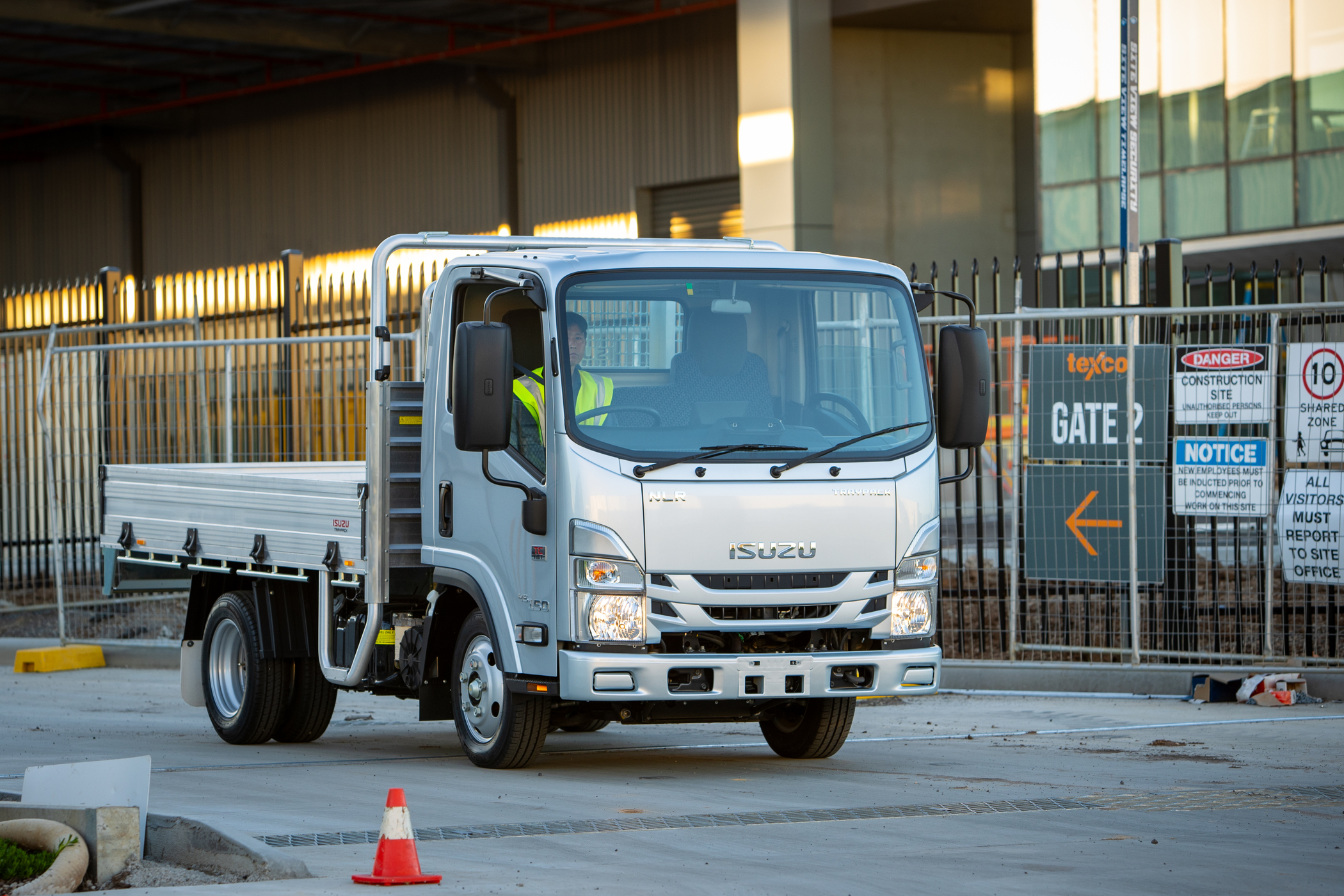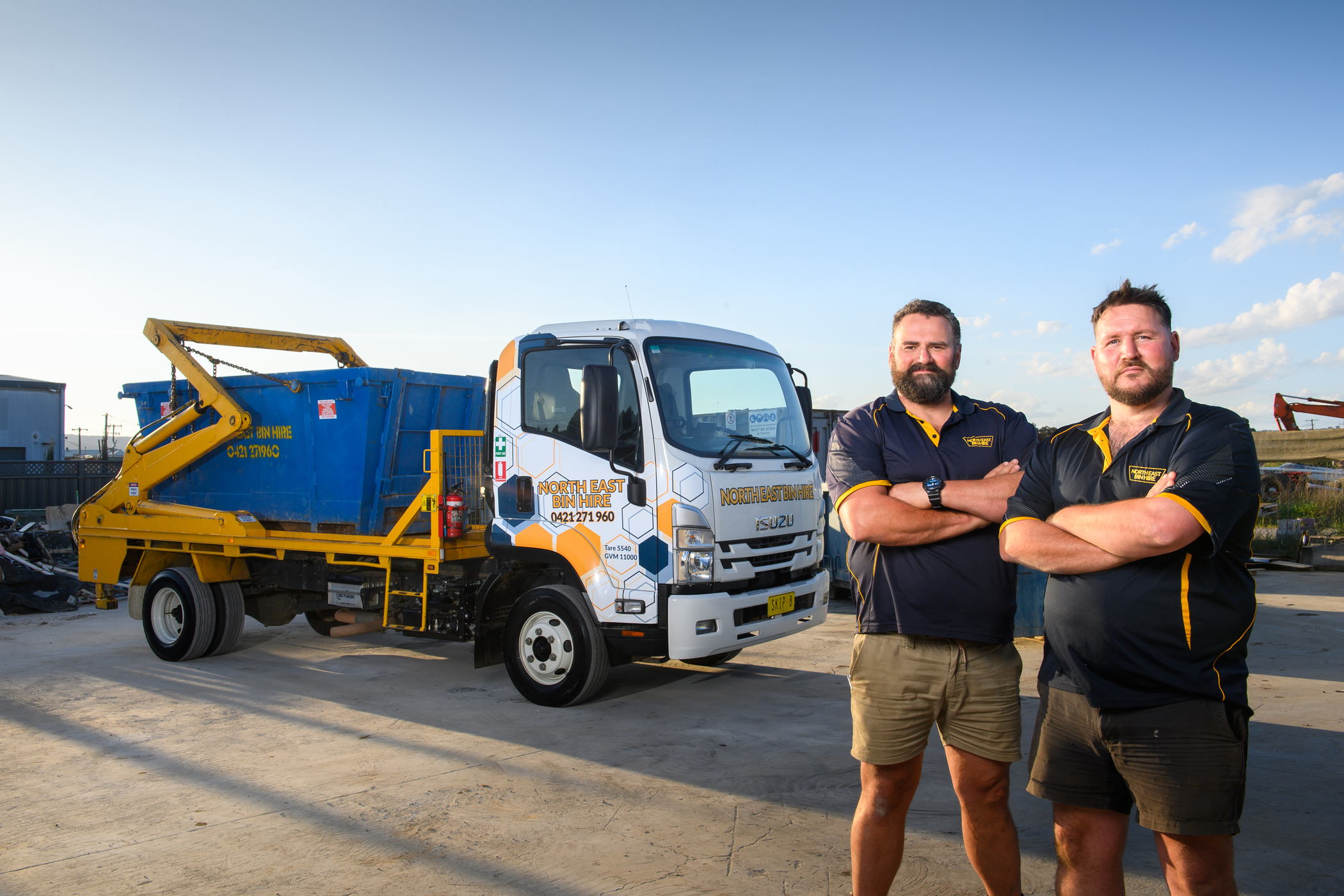THREE DIMENSIONAL: NLR TRI-TIPPER REVIEW
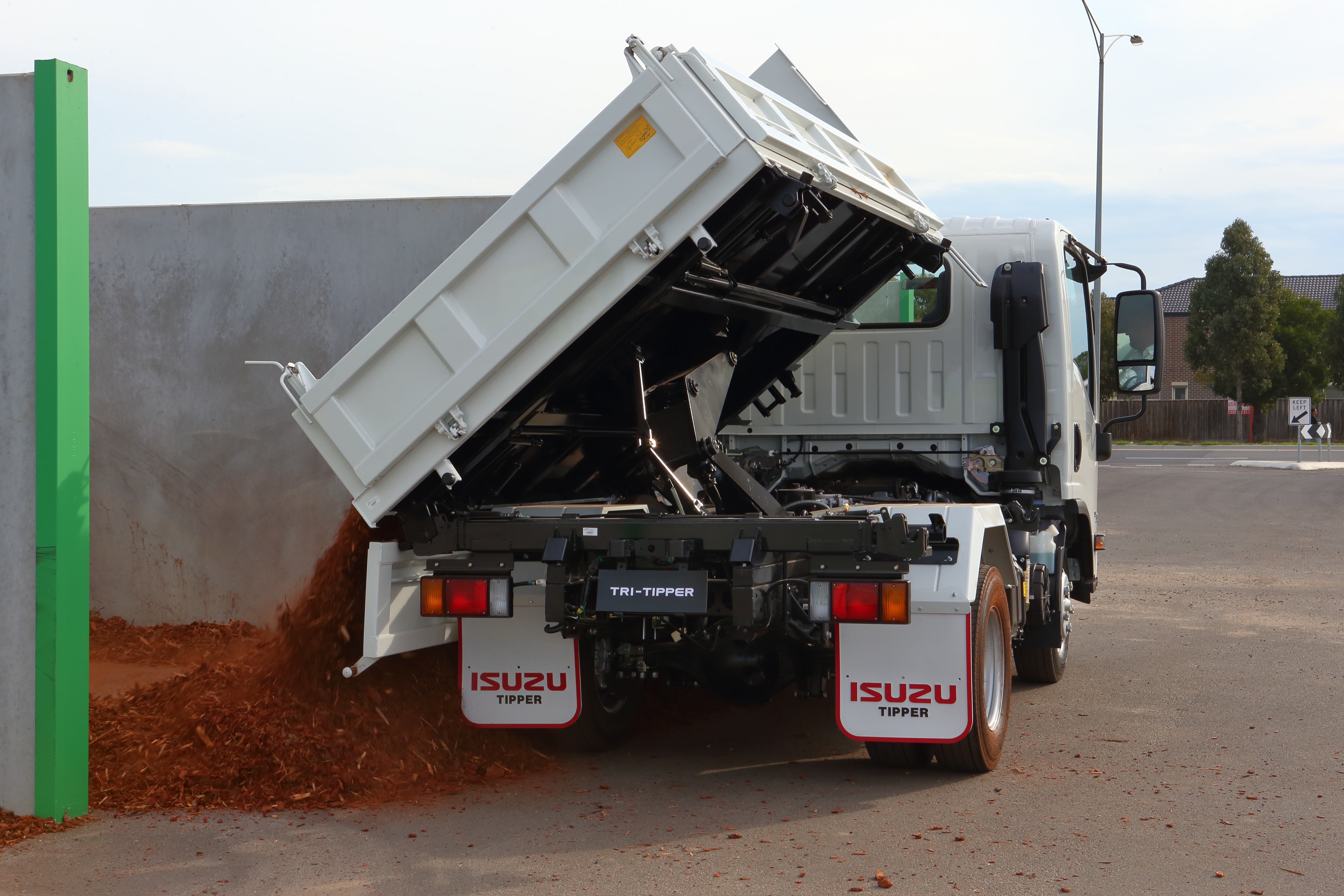
One of the key new model releases at this year’s Brisbane Truck Show was the Isuzu NLR 55/45- 150 Tri-Tipper. This release sparked great interest from the trucking community, and the number of enquiries and subsequent orders of this unique new offering have inundated Isuzu.
Isuzu imports a number of ‘factory-tippers’ in a traditional rear tipping setup. This new Tri-Tripper is the first the company has imported with its unique three-way tipping operation. The body can be tipped from the rear as a conventional tipping body, or, alternatively, the driver can turn a short lever in the cabin to the left or the right, which correspondingly then tips the body to the selected side when the driver operates a long lever mounted on the right-hand-side of the dashboard.
 What’s unique about this body is that changing from left to rear to right side tipping is all done from inside the cabin by the operator simply moving a short lever located on the floor in front of the centre seat into one of three positions, 9 o’clock for left side tip, 12 o’clock for rear tip and 3 o’clock for right side tip.
Unlike many other three-way tipping bodies produced locally and in Europe, there are no pins to locate, levers to move or other modifications to make outside of the vehicle. This simplifies the total operation and reduces the risk of driver injury, by getting fingers jammed in pins, levers and ball joints. Furthermore, there is significantly less risk of damage to the superstructure of the body due to operator error from not having pins locked correctly before operating the tipper control.
As with most tippers, the lifting of the body is done via a hydraulic hoist, operated by a transmission-driven power-take-off (PTO). Unlike most gearbox-mounted PTOs, the driver does not need to put a foot on the clutch prior to operating the PTO. When the driver pulls the tip lever, the truck engages the PTO without needing to operate the clutch, and also raises the tipper body at the same time. However, the truck needs to be stationery and the gearbox needs to be in neutral when this operation is carried out.
When spreading material such as stone, sand or gravel, forward motion can be achieved by selecting first gear (after the PTO has been engaged) and then moving forward by the driver releasing the clutch. As with a regular transmission PTO, when the clutch is disengaged the PTO will stop pumping, and, as such, the tipper body will halt lifting. The tipper raises and lowers to full height in a remarkable 20 seconds.
The big advantage of the Tri-Tipper is that it allows the tipper body to be tipped when the truck has a trailer attached without the need for disconnecting.
What’s unique about this body is that changing from left to rear to right side tipping is all done from inside the cabin by the operator simply moving a short lever located on the floor in front of the centre seat into one of three positions, 9 o’clock for left side tip, 12 o’clock for rear tip and 3 o’clock for right side tip.
Unlike many other three-way tipping bodies produced locally and in Europe, there are no pins to locate, levers to move or other modifications to make outside of the vehicle. This simplifies the total operation and reduces the risk of driver injury, by getting fingers jammed in pins, levers and ball joints. Furthermore, there is significantly less risk of damage to the superstructure of the body due to operator error from not having pins locked correctly before operating the tipper control.
As with most tippers, the lifting of the body is done via a hydraulic hoist, operated by a transmission-driven power-take-off (PTO). Unlike most gearbox-mounted PTOs, the driver does not need to put a foot on the clutch prior to operating the PTO. When the driver pulls the tip lever, the truck engages the PTO without needing to operate the clutch, and also raises the tipper body at the same time. However, the truck needs to be stationery and the gearbox needs to be in neutral when this operation is carried out.
When spreading material such as stone, sand or gravel, forward motion can be achieved by selecting first gear (after the PTO has been engaged) and then moving forward by the driver releasing the clutch. As with a regular transmission PTO, when the clutch is disengaged the PTO will stop pumping, and, as such, the tipper body will halt lifting. The tipper raises and lowers to full height in a remarkable 20 seconds.
The big advantage of the Tri-Tipper is that it allows the tipper body to be tipped when the truck has a trailer attached without the need for disconnecting.
 Furthermore, if this truck was used to add mulch to garden beds in median strips, council workers would only need to block the inner lane, as the truck could be driven while spreading the mulch from either the left or right-hand-side. This is so much more efficient and safer for the operator than with a standard rear tip body where two lanes would need to be closed for the truck to reverse and dump, then reposition before repeating the operation in different locations.
The Tri-Tipper is available in two GVMs that facilitate the vehicle being driven by both those with a light truck licence or a car licence. At the 5500 kg GVM a light truck licence is required, however the truck can be de-rated to 4500 kg for those operating the vehicle on a car licence.
The tare weight of the truck is stated at 3045 kg, which would legally allow approximately 1.5 tonnes of legal payload on a car licence variant, and 2.5 tonnes of payload when the truck is rated at 5500 kg and a light truck licence is in use.
The Isuzu 4JJ1-TCS engine, with its 3.0 litres capacity, featuring four cylinders with turbocharging and intercooling is the powerplant for the NLR 55/45-150. The 4JJ1-TCS produces 110 kW (148 hp) at 2800 rpm and 375 Nm of torque at 1600-2800 rpm. Mounted to the back of the engine is a five-speed overdrive fully synchromesh Isuzu manual gearbox.
In fifth gear (overdrive) the truck is doing 2550 rpm at 100 km/h via a final drive ratio of 4.777:1. Currently, the truck is only available with a manual transmission, but Isuzu is looking into introducing an AMT version to add further appeal to customers, particularly in local council applications.
Furthermore, if this truck was used to add mulch to garden beds in median strips, council workers would only need to block the inner lane, as the truck could be driven while spreading the mulch from either the left or right-hand-side. This is so much more efficient and safer for the operator than with a standard rear tip body where two lanes would need to be closed for the truck to reverse and dump, then reposition before repeating the operation in different locations.
The Tri-Tipper is available in two GVMs that facilitate the vehicle being driven by both those with a light truck licence or a car licence. At the 5500 kg GVM a light truck licence is required, however the truck can be de-rated to 4500 kg for those operating the vehicle on a car licence.
The tare weight of the truck is stated at 3045 kg, which would legally allow approximately 1.5 tonnes of legal payload on a car licence variant, and 2.5 tonnes of payload when the truck is rated at 5500 kg and a light truck licence is in use.
The Isuzu 4JJ1-TCS engine, with its 3.0 litres capacity, featuring four cylinders with turbocharging and intercooling is the powerplant for the NLR 55/45-150. The 4JJ1-TCS produces 110 kW (148 hp) at 2800 rpm and 375 Nm of torque at 1600-2800 rpm. Mounted to the back of the engine is a five-speed overdrive fully synchromesh Isuzu manual gearbox.
In fifth gear (overdrive) the truck is doing 2550 rpm at 100 km/h via a final drive ratio of 4.777:1. Currently, the truck is only available with a manual transmission, but Isuzu is looking into introducing an AMT version to add further appeal to customers, particularly in local council applications.
 Another unique feature of the little Isuzu is its suspension setup. In place of the conventional solid I-beam front axles, the NLR has a fully independent front end that uses coil springs and double-acting hydraulic shock absorbers. As with most car suspension systems, an independent front end provides much better ride and handling than a live front axle can offer. At the rear, Isuzu uses a typical taper leaf main spring, with a helper taper leaf for when the truck is at high weights. The rear axle is a live axle, rather than an independent like the front end.
Out on the open road, the Isuzu performs really well. The independent front end makes ride and handling much better than older Japanese light trucks, and, whilst the rear end was a bit bumpy, it was difficult to give an accurate assessment, as there was no payload in the tipper body. The four-cylinder diesel engine is both quiet and refined, and has no problems sitting on 100 km/h without portraying any of the excessive noise or harshness found in Japanese trucks of yesteryear. The five-speed box is really enjoyable to operate, and, even for those who find a manual somewhat difficult to drive, this one makes it easy, due to its short-throw and also its smooth and lightweight gearshifts. Whilst cruise control is available as an option, it would be a nice touch if Isuzu could include this as standard equipment.
When it comes to standard safety features, the driver is not left wanting, with an array of features as standard. Included are Isuzu’s electronic stability control (IESC), ABS, traction control (ASR), hill-start assist (HSA) and also electronic brake force distribution (EBD). Inside the cab, there are driver and passenger airbags, seatbelt pretensioners and the cabin is ECE-R29 compliant.
Another unique feature of the little Isuzu is its suspension setup. In place of the conventional solid I-beam front axles, the NLR has a fully independent front end that uses coil springs and double-acting hydraulic shock absorbers. As with most car suspension systems, an independent front end provides much better ride and handling than a live front axle can offer. At the rear, Isuzu uses a typical taper leaf main spring, with a helper taper leaf for when the truck is at high weights. The rear axle is a live axle, rather than an independent like the front end.
Out on the open road, the Isuzu performs really well. The independent front end makes ride and handling much better than older Japanese light trucks, and, whilst the rear end was a bit bumpy, it was difficult to give an accurate assessment, as there was no payload in the tipper body. The four-cylinder diesel engine is both quiet and refined, and has no problems sitting on 100 km/h without portraying any of the excessive noise or harshness found in Japanese trucks of yesteryear. The five-speed box is really enjoyable to operate, and, even for those who find a manual somewhat difficult to drive, this one makes it easy, due to its short-throw and also its smooth and lightweight gearshifts. Whilst cruise control is available as an option, it would be a nice touch if Isuzu could include this as standard equipment.
When it comes to standard safety features, the driver is not left wanting, with an array of features as standard. Included are Isuzu’s electronic stability control (IESC), ABS, traction control (ASR), hill-start assist (HSA) and also electronic brake force distribution (EBD). Inside the cab, there are driver and passenger airbags, seatbelt pretensioners and the cabin is ECE-R29 compliant.
 The truck is really well spec’d and the driver doesn’t miss out on many of the goodies typically found in a bigger trucks. Standard is a 6.2-inch touchscreen enabled audiovisual system that includes Bluetooth phone functionality, AM/FM radio as well as DAB digital radio.
As an option, the owner can purchase an SD card from their local Isuzu dealer to enable the system for GPS navigation and mapping, however it would be nice to see this made standard equipment. Furthermore, the truck has large, heated and electrically adjustable mirrors, and cornering lamps, as well as Michelin tyres all as standard equipment.
However you look at it, the Isuzu Tri-Tipper is an impressive package and will appeal to a myriad of operators for various applications. Hopefully we will see Isuzu introduce more tri-tippers on some of its bigger trucks to expand the range further!
[image_gallery][/image_gallery]
The truck is really well spec’d and the driver doesn’t miss out on many of the goodies typically found in a bigger trucks. Standard is a 6.2-inch touchscreen enabled audiovisual system that includes Bluetooth phone functionality, AM/FM radio as well as DAB digital radio.
As an option, the owner can purchase an SD card from their local Isuzu dealer to enable the system for GPS navigation and mapping, however it would be nice to see this made standard equipment. Furthermore, the truck has large, heated and electrically adjustable mirrors, and cornering lamps, as well as Michelin tyres all as standard equipment.
However you look at it, the Isuzu Tri-Tipper is an impressive package and will appeal to a myriad of operators for various applications. Hopefully we will see Isuzu introduce more tri-tippers on some of its bigger trucks to expand the range further!
[image_gallery][/image_gallery]


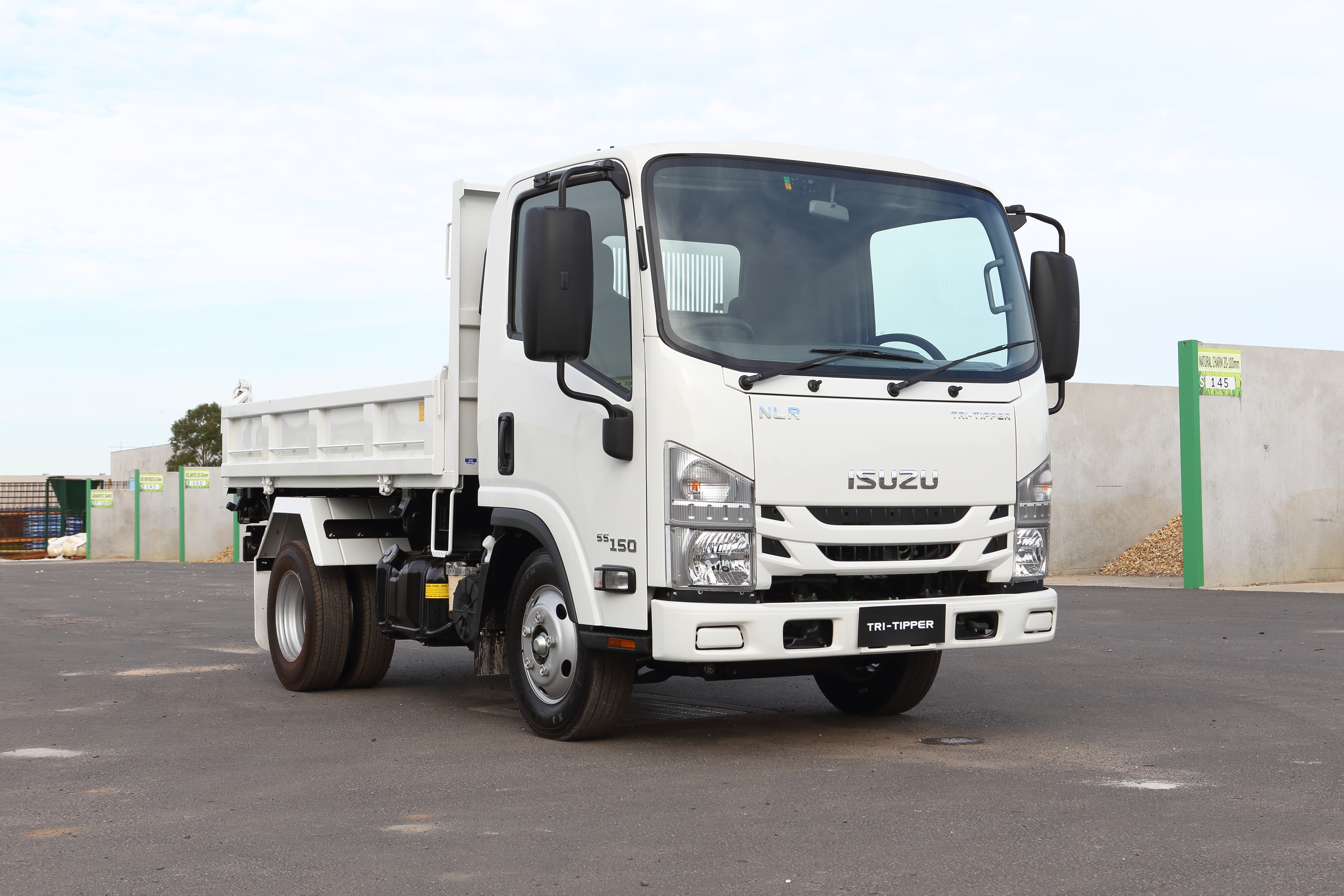
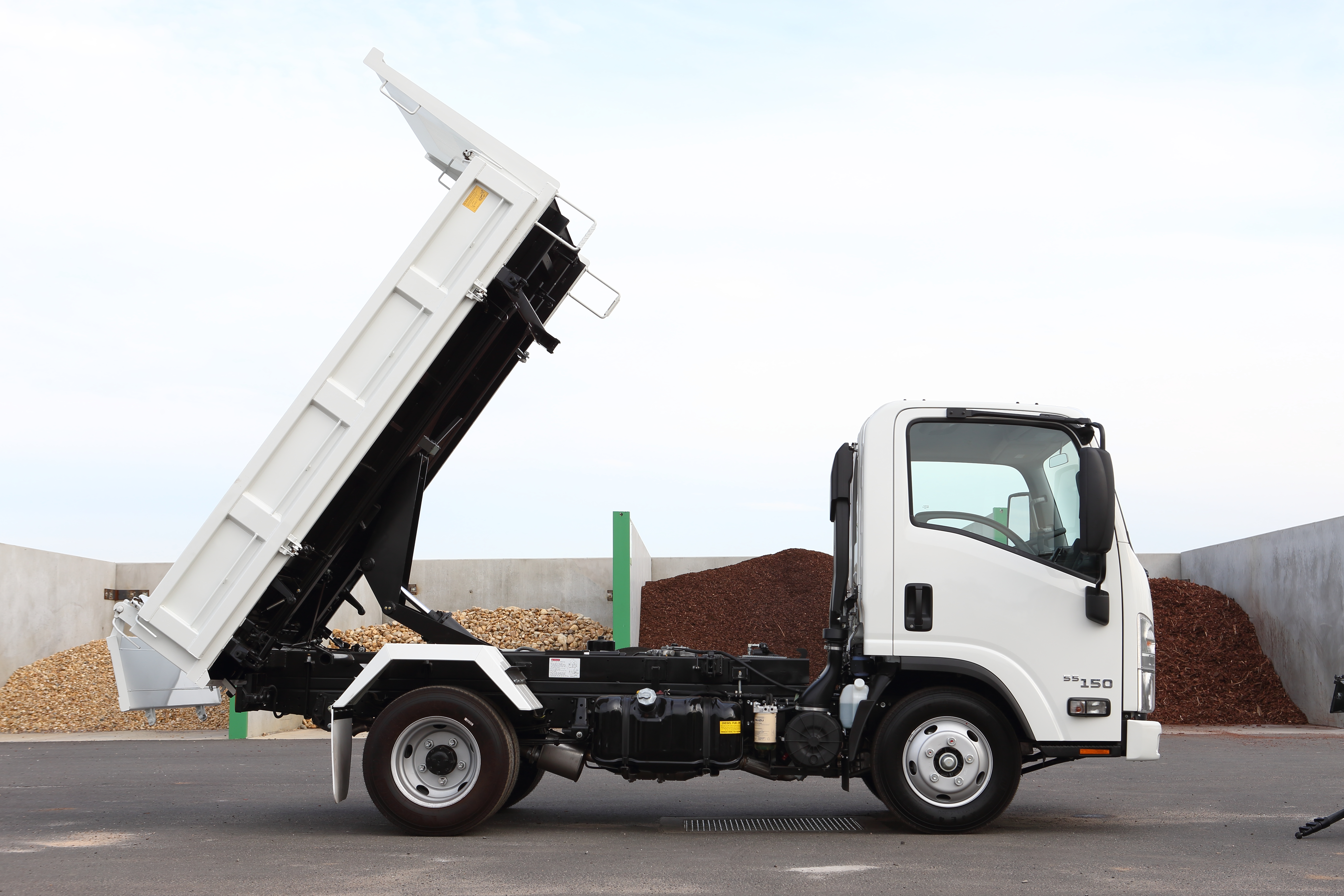

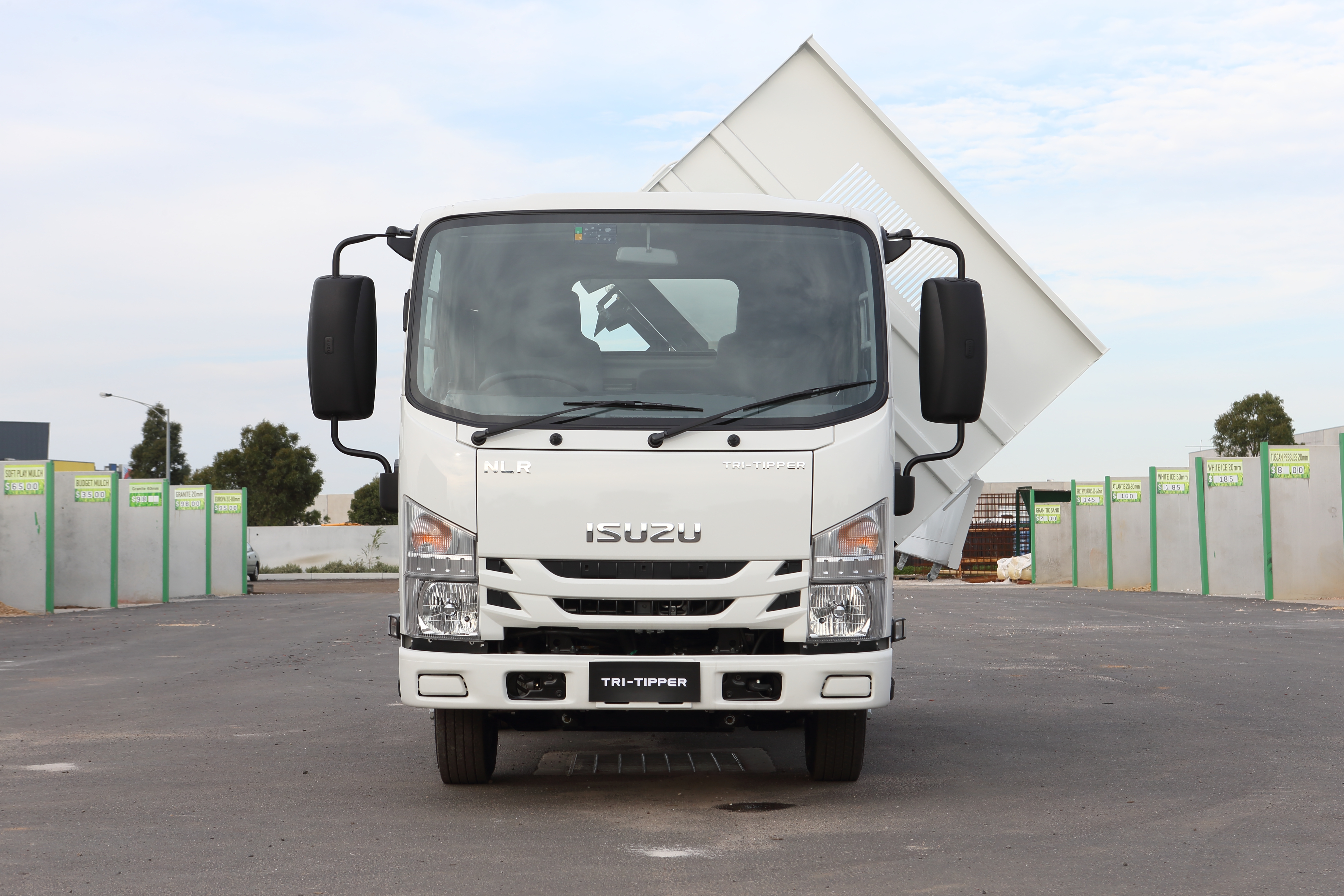


Playtime’s over, get $3,500* to spend on extras.
If you’re ready to get serious about tackling bigger jobs, grab yourself an NLR 45-150 AMT SWB Traypack from the Ready-to-Work range for $62,990 drive away*. And to prove we aren’t playing, buy any NLR Traypack before June 30 and you’ll get $3,500* to spend on genuine accessories or an Essentials service agreement.
Learn more
